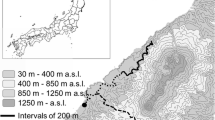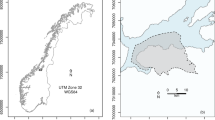Abstract
Disturbed habitats are often swiftly colonized by alien plant species. Human inhabited areas may act as sources from which such aliens disperse, while road verges have been suggested as corridors facilitating their dispersal. We therefore hypothesized that (i) houses and urban areas are propagule sources from which aliens disperse, and that (ii) road verges act as corridors for their dispersal. We sampled presence and cover of aliens in 20 plots (6 × 25 m) per road at 5-km intervals for four roads, nested within three localities around cities (n = 240). Plots consisted of three adjacent nested transects. Houses (n = 3,349) were mapped within a 5-km radius from plots using topographical maps. Environmental processes as predictors of alien composition differed across spatial levels. At the broadest scale road-surface type, soil type, and competition from indigenous plants were the strongest predictors of alien composition. Within localities disturbance-related variables such as distance from dwellings and urban areas were associated with alien composition, but their effect differed between localities. Within roads, density and proximity of houses was related to higher alien species richness. Plot distance from urban areas, however, was not a significant predictor of alien richness or cover at any of the spatial levels, refuting the corridor hypothesis. Verges hosted but did not facilitate the spread of alien species. The scale dependence and multiplicity of mechanisms explaining alien plant communities found here highlight the importance of considering regional climatic gradients, landscape context and road-verge properties themselves when managing verges.







Similar content being viewed by others
References
Arévalo JR, Delgado JD, Otto R et al (2005) Distribution of alien vs. native plant species in roadside communities along an altitudinal gradient in Tenerife and Gran Canaria (Canary Islands). Perspect Plant Ecol Evol Syst 7:185–202
Barton AM, Brewster LB, Cox AN et al (2004) Non-indigenous woody invasive plants in a rural New England town. Biol Invasions 6:205–211
Beier P, Noss RF (1998) Do habitat corridors provide connectivity? Conserv Biol 12:1241–1252
Bullock JM, Clarke RT (2000) Long distance seed dispersal by wind: measuring and modelling the tail of the curve. Oecologia 124:506–521
Chief Directorate of Surveys and Mapping (c1998) Topographical Maps (scale 1:50 000). Chief Directorate: Surveys and Mapping, Mowbray, South Africa
Christen D, Matlack G (2006) The role of roadsides in plant invasions: a demographic approach. Conserv Biol 20:385–391
Cilliers SS, Bredenkamp GJ (2000) Vegetation of road verges on an urbanisation gradient in Potchefstroom, South Africa. Landsc Urban Plan 46:217–239
Crawley MJ, Brown SL (2004) Spatially structured population dynamics in feral oilseed rape. Proc R Soc Lond B Bio 271:1909–1916
Dauer JT, Mortensen DA, Van Gessel MJ (2007) Temporal and spatial dynamics of long-distance Conyza canadensis seed dispersal. J Appl Ecol 44:105–114
Esler KJ, Milton SJ (2006) Towards best practice in management of road, power line and rail reserves. DST-NRF Centre of Excellence for Invasion Biology, Stellenbosch, South Africa: Occasional Paper 1
Fagan WE, Cantrell RS, Cosner C (1999) How habitat edges change species interactions. Am Nat 153:165–182
Flory SL, Clay K (2006) Invasive shrub distribution varies with distance to roads and stand age in eastern deciduous forests in Indiana, USA. Plant Ecol 184:131–141
Forman RTT (2003) Road ecology: science and solutions. Island Press, Washington, DC
Gelbard JL, Belnap J (2003) Roads as conduits for exotic plant invasions in a semiarid landscape. Conserv Biol 17:420–432
Germishuizen G, Meyer NL (2003) Plants of southern Africa: an annotated checklist. National Botanical Institute, Pretoria
Gonzalez A, Lawton JH, Gilbert FS et al (1998) Metapopulation dynamics, abundance, and distribution in a microecosystem. Science 281:2045–2047
Grapow LC, Blasi C (1998) A comparison of the urban flora of different phytoclimatic regions in Italy. Global Ecol Biogeogr 7:367–378
Gross J (2003) Variance inflation factors. R News 3:13–15
Hansen MJ, Clevenger AP (2005) The influence of disturbance and habitat on the presence of non-native plant species along transport corridors. Biol Conserv 125:249–259
Hazell P, Gustafsson L (1999) Retention of trees at final harvest—evaluation of a conservation technique using epiphytic bryophyte and lichen transplants. Biol Conserv 90:133–142
Henderson L (2001) Alien weeds and invasive plants. A complete guide to declared weeds and invaders in South Africa. Paarl Printers, Cape Town, South Africa
Johnston FM, Johnston SW (2004) Impacts of road disturbance on soil properties and on exotic plant occurrence in subalpine areas of the Australian Alps. Arct Antarct Alp Res 36:201–207
Kraaij T, Milton SJ (2006) Vegetation changes (1995–2004) in semi-arid Karoo shrubland, South Africa: effects of rainfall, wild herbivores and change in land use. J Arid Environ 64:174–192
Larson DL (2003) Native weeds and exotic plants: relationships to disturbance in mixed-grass prairie. Plant Ecol 169:317–333
Lepš J, Šmilauer P (1999) Multivariate analysis of ecological data. Faculty of Biological Sciences, University of South Bohemia, Ceské Budejovice
Levey DJ, Bolker BM, Tewksbury JJ et al (2005) Effects of landscape corridors on seed dispersal by birds. Science 309:146–148
Levin SA, Muller-Landau HC, Nathan R et al (2003) The ecology and evolution of seed dispersal: a theoretical perspective. Annu Rev Ecol Evol Syst 34:575–604
Lonsdale WM, Lane AM (1994) Tourist vehicles as vectors of weed seeds in Kakadu National Park, Northern Australia. Biol Conserv 69:277–283
Lynch, SD (2003) The development of a raster database of annual, monthly and daily rainfall for southern Africa. Water Research Commission, Pretoria, South Africa: WRC Report 1156/0/1, 78 pp plus Appendices
McCullagh P, Nelder JA (1989) Generalized linear models. Chapman & Hall, London, UK
McGeoch MA, Gaston KJ (2000) Edge effects on the prevalence and mortality factors of Phytomyza ilicis (Diptera, Agromyzidae) in a suburban woodland. Ecol Lett 3:23–29
Milberg P, Lamont BB (1995) Fire enhances weed invasion of roadside vegetation in Southwestern Australia. Biol Conserv 73:45–49
Milton SJ (2004) Grasses as invasive alien plants in South Africa. S Afr J Sci 100:69–75
Milton SJ, Dean WRJ (1998) Alien plant assemblages near roads in arid and semi-arid South Africa. Divers Distrib 4:175–187
Morton R (1987) A generalized linear model with nested strata of extra-Poisson variation. Biometrika 74:247–257
Mucina L., Rutherford M. C. 2006. The vegetation of South Africa, Lesotho and Swaziland. Strelitzia 19. South African National Biodiversity Institute, Pretoria, South Africa
Mueller-Dombois D, Ellenberg H (1974) Aims and methods of vegetation ecology. Wiley, New York, USA
Myers RH, Montgomery DC, Vining GG (2002) Generalized linear models: with applications in engineering and the sciences. Wiley, New York, NY, USA
Nathan R (2006) Long-distance dispersal of plants. Science 313:786–788
O’Farrell PJ, Milton SJ (2005) Road verge and rangeland plant communities in the southern Karoo: exploring what influences diversity, dominance and cover. Biodivers Conserv 15:921–938
Pauchard A, Alaback PB (2004) Influence of elevation, land use, and landscape context on patterns of alien plant invasions along roadsides in protected areas of south-central Chile. Conserv Biol 18:238–248
Petit RJ (2004) Biological invasions at the gene level. Divers Distrib 10:159–165
Procheş Ş, Wilson JRU, Veldtman R et al (2005) Landscape corridors: Possible dangers? Science 310:779
Qian H, Ricklefs RE (2006) The role of exotic species in homogenizing the North American flora. Ecol Lett 9:1293–1298
Quinn GP, Keough MJ (2002) Experimental design and data analysis for biologists. Cambridge University Press, Cambridge, UK
Rentch JS, Fortney RH, Stephenson SL et al (2005) Vegetation-site relationships of roadside plant communities in West Virginia, USA. J Appl Ecol 42:129–138
Richardson DM, Pyšek P, Rejmánek M et al (2000) Naturalization and invasion of alien plants: concepts and definitions. Divers Distrib 6:93–107
Ries L, Debinski DM, Wieland ML (2001) Conservation value of roadside prairie restoration to butterfly communities. Conserv Biol 15:401–411
Rouget M, Richardson DM, Nel JL et al (2004) Mapping the potential ranges of major plant invaders in South Africa, Lesotho and Swaziland using climatic suitability. Divers Distrib 10:475–484
Saarinen K, Valtonen A, Jantunen J et al (2005) Butterflies and diurnal moths along road verges: Does road type affect diversity and abundance? Biol Conserv 123:403–412
Sax DF, Brown JH (2000) The paradox of invasion. Global Ecol Biogeogr 9:363–371
Schmidt W (1989) Plant dispersal by motor cars. Vegetatio 80:147–152
Spellerberg IF (1998) Ecological effects of roads and traffic: a literature review. Global Ecol Biogeogr 7:317–333
Spooner PG, Lunt ID (2004) The influence of land-use history on roadside conservation values in an Australian agricultural landscape. Aust J Bot 52:445–458
Spooner PG, Lunt ID, Briggs SV (2004) Spatial analysis of anthropogenic disturbance regimes and roadside shrubs in a fragmented agricultural landscape. Appl Veg Sci 7:61–70
Sýkora KV, Kalwij JM, Keizer PJ (2002) Phytosociological and floristic evaluation of a 15-year ecological management of roadside verges in the Netherlands. Preslia 74:421–436
USGS (2004) Three arc seconds SRTM elevation data, reprocessed to GeoTIFF. University of Maryland, College Park, Maryland
Von der Lippe M, Kowarik I (2007) Long-distance dispersal of plants by vehicles as a driver of plant invasions. Conserv Biol 21:986–996
Von Holle B, Simberloff D (2005) Ecological resistance to biological invasion overwhelmed by propagule pressure. Ecology 86:3212–3218
Wenny DG (2001) Advantages of seed dispersal: a re-evaluation of directed dispersal. Evol Eco Res 3:51–74
Wester L, Juvik JO (1983) Roadside plant communities on Mauna Loa, Hawaii. J Biogeogr 10:307–316
Wilson JB, Rapson GL, Sykes MT et al (1992) Distributions and climatic correlations of some exotic species along roadsides in South Island, New Zealand. J Biogeogr 19:183–194
Zwaenepoel A, Roovers P, Hermy M (2006) Motor vehicles as vectors of plant species from road verges in a suburban environment. Basic Appl Ecol 7:83–93
Acknowledgments
This project was funded by the DST-NRF Center of Excellence for Invasion Biology. We are grateful to A. Y. van Zonneveld and H. Tulp for field assistance, to G. Pretorius for logistic support, to J. J. Kalwij for help with literature access, and to K. V. Sýkora for fruitful discussions. K.J. Esler provided valuable comment on the manuscript.
Author information
Authors and Affiliations
Corresponding author
Electronic supplementary material
Below is the link to the electronic supplementary material.
Rights and permissions
About this article
Cite this article
Kalwij, J.M., Milton, S.J. & McGeoch, M.A. Road verges as invasion corridors? A spatial hierarchical test in an arid ecosystem. Landscape Ecol 23, 439–451 (2008). https://doi.org/10.1007/s10980-008-9201-3
Received:
Accepted:
Published:
Issue Date:
DOI: https://doi.org/10.1007/s10980-008-9201-3




